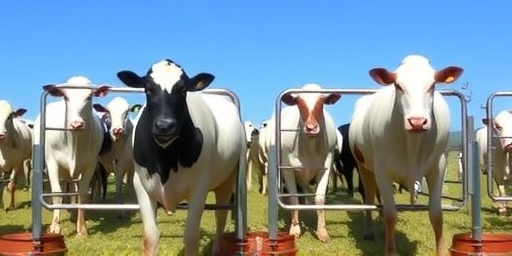In a development that has heightened concerns across the U.S. agricultural sector, health officials have confirmed the first human case of H5N1 Bird flu this season in a California dairy worker exposed to infected cattle. The announcement, made by the California Department of Public Health (CDPH) on Thursday, marks the latest spillover from ongoing outbreaks in dairy herds and prompts intensified monitoring nationwide.
The worker, who experienced mild respiratory symptoms and conjunctivitis after close contact with sick cows, has fully recovered and poses no ongoing public health risk, according to officials. This case brings the total number of human H5N1 infections linked to U.S. dairy cattle to five since March, underscoring the virus’s adaptation to mammals while reassuring the public that no human-to-human transmission has been detected.
California Dairy Worker’s H5N1 Exposure Traced to Infected Herd
The infected dairy worker, a 42-year-old man from Fresno County in central California, first reported symptoms on October 15. He sought medical attention after developing eye redness and mild flu-like symptoms, which prompted testing at a local clinic. Samples were sent to the CDC for confirmation, revealing the presence of the H5N1 avian influenza virus, specifically the D1.1 genotype circulating in U.S. dairy cattle.
“This individual had direct, unprotected contact with cows exhibiting signs of illness, including reduced milk production and abnormal udder swelling,” stated Dr. Tomas Aragon, CDPH Director, in a press release. “Importantly, the patient received prompt antiviral treatment with oseltamivir and has returned to full health without complications.”
Fresno County, a hub for California‘s $7 billion dairy industry, has seen multiple herd confirmations of Bird flu since the summer. State veterinarians identified the source herd last month, culling affected animals under USDA protocols. Genetic sequencing showed the virus strain matched those from previous human cases in Colorado, Michigan, and Missouri, indicating a common bovine reservoir.
Escalating Dairy Cattle Outbreaks Fuel Human Spillover Risks
The human case arrives amid a surging H5N1 epidemic in U.S. dairy operations. Since late 2023, the virus has infected over 880 herds across 16 states, with California reporting 35 confirmed outbreaks—the second-highest after Michigan’s 150+. Federal data from the USDA Animal and Plant Health Inspection Service (APHIS) reveals milk samples testing positive at rates up to 40% in some high-risk regions.
Experts attribute the spread to the virus’s high contagiousness in lactating cows, transmitted via unpasteurized milk, respiratory droplets, and contaminated equipment. “Bird flu in cattle is unprecedented in scale,” noted Dr. Angela Rasmussen, a virologist at the University of Saskatchewan’s Vaccine and Infectious Disease Organization. “Pasteurization effectively kills the virus, so commercial milk remains safe, but raw milk handlers and farmworkers are at elevated risk.”
Raw milk sales, popular in niche markets, have drawn scrutiny. The FDA has issued warnings against consuming unpasteurized products from affected areas, citing viable virus in bulk tank milk from infected herds. Economic losses mount, with the dairy industry estimating $1.2 billion in impacts from depopulation, testing, and lost productivity as of October 2024.
- Key Stats on Dairy Outbreaks:
- 880+ herds affected nationwide
- 16 states involved, led by MI (150+), ID (100+), CA (35)
- Human cases: 5 total, all mild, occupationally linked
- Virus detection in 1 in 5 retail milk samples (early 2024 peak)
CDC Launches Enhanced Surveillance After California Confirmation
In response to the new human case, the Centers for Disease Control and Prevention (CDC) has expanded its H5N1 monitoring program, prioritizing dairy workers in outbreak zones. “We’re distributing millions of doses of seasonal flu vaccine to farms and conducting voluntary nasal swab testing for exposed individuals,” said CDC Director Dr. Mandy Cohen during a Friday briefing.
The agency reports testing over 40 close contacts of the California patient—all negative for H5N1. Genomic analysis confirms the virus remains avian-adapted, with no mutations suggesting efficient human transmission. Risk to the general public stays low at 1 in 400,000 annualized probability, per CDC models, comparable to sporadic seasonal flu exposures.
State-level actions include California‘s mandate for enhanced biosecurity on dairy farms: mandatory PPE for milkers, twice-daily health checks, and rapid reporting of sick animals. The USDA is fast-tracking a cattle vaccine trial, with field tests slated for 2025, potentially curbing future spillovers.
“This case is a wake-up call, but our layered defenses—surveillance, antivirals, and vaccines—are holding strong,” Dr. Cohen emphasized. “Farmworkers are our frontline; protecting them protects us all.”
Expert Warnings on Raw Milk and Farm Safety Gaps
As bird flu concerns ripple through communities, public health advocates spotlight raw milk risks. The Pasteurized Milk Ordinance, enforced since 1924, has slashed dairy-related illnesses by 99%, yet 3% of U.S. consumers seek unpasteurized alternatives for perceived benefits. “H5N1 survives pasteurization temperatures briefly but not long enough for danger; raw milk is a different story,” warns FDA Commissioner Dr. Robert Califf.
Farmworker vulnerabilities compound issues. Many lack consistent PPE access, with turnover rates exceeding 50% annually in dairy. Advocacy groups like Farmworker Justice call for federal subsidies for protective gear and paid sick leave. “These essential workers feed America but often can’t afford basic safeguards,” said executive director Virginia Ruiz.
Internationally, parallels emerge: H5N1 has killed 60% of 900+ human cases since 2003, mostly in Asia from poultry. U.S. dairy-linked strains show lower severity (0% fatality), but experts urge vigilance. “Sustained mammal transmission could evolve the virus,” cautions WHO avian flu coordinator Dr. Wenqing Zhang.
- Recommended Precautions for Dairy Workers:
- Wear goggles, masks, gloves during milking
- Avoid raw milk consumption or contact
- Report symptoms immediately for testing
- Vaccinate against seasonal flu to prevent co-infection
Future Outlook: Vaccine Trials and Policy Shifts Ahead
Looking ahead, the H5N1 saga shapes U.S. policy. Congress debates $1 billion in farm biosecurity funding, while the USDA eyes indemnity expansions for vaccinated herds. Human vaccine stockpiles—over 100 million doses—stand ready for clade 2.3.4.4b strains, adaptable within months if needed.
California‘s case accelerates research: NIH-funded studies probe mammalian adaptation, with early data suggesting milk droplets as super-spreaders. Industry leaders, via the International Dairy Foods Association, pledge compliance while resisting broad culls. “Sustainable control balances animal health, worker safety, and food security,” said president and CEO Michael Galvin.
Public education campaigns ramp up, targeting rural areas with multilingual resources. As winter looms—peak flu season—officials anticipate upticks but express confidence in tools at hand. This human case reinforces that while bird flu persists, proactive measures keep it contained, safeguarding the nation’s dairy supply and workforce.
(Article includes data from CDC, USDA, CDPH as of October 25, 2024. Updates will follow new developments.)









